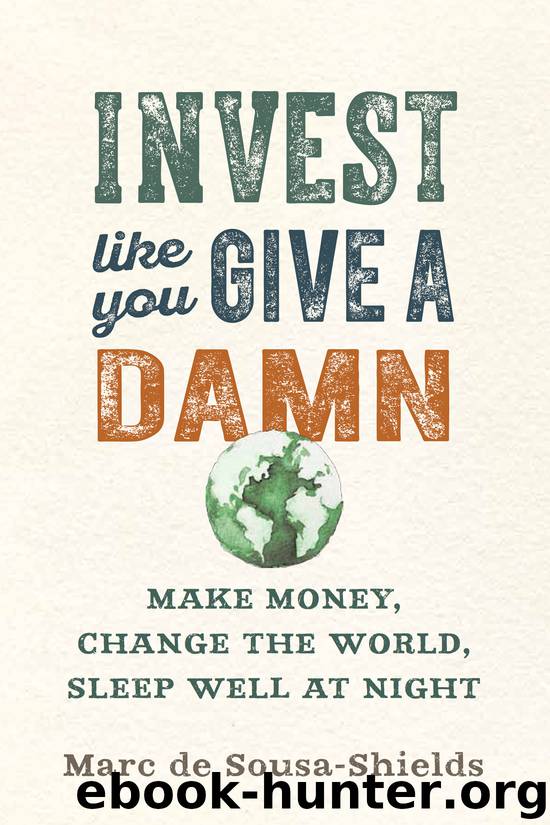Invest Like You Give a Damn by Marc de Sousa-Shields

Author:Marc de Sousa-Shields
Language: eng
Format: epub
Publisher: New Society Publishers
Published: 2017-03-14T04:00:00+00:00
What is Financial Asset Allocation?
Buying the right mix of investments is a way to avoid having to guess at future market conditions and the performance of a given security. Investors use many strategies to get the mix right. Among the most common, successful, and simple to use, in my judgment, is asset allocation.
Asset allocation is a serious subject. It is so serious, if you Google “Asset Allocation Humor” you get a big Zero. Nada; rien; nichts. It’s either that serious or investment folk have no humor. (If you ask Google for investment humor, on the other hand, you get some gems, including this one, from investment professional Charlie Munger: “It is remarkable how much long-term advantage people like us have gotten by trying to be consistently not stupid, instead of trying to be very intelligent.”)
So, what is this humorless thing, asset allocation?
According to Investopedia, asset allocation is an investment practice that balances risk and reward by dividing your portfolio according to your investment goals, risk tolerance, and investment horizon or how much you want to make, how afraid or unafraid you are of the market, and how long it will be before you need the money you are investing. Asset allocation in practice means how much equity, bonds, or cash as a percentage of your total capital you hold in your portfolio.
As you know, there are many classes of stocks and bonds, and the performance of each varies consistently under specific economic and market conditions. Some tend to go up in one type of market, while others tend to go down. Growth economies are good for equities, those of smaller companies in particular. Bonds are often better in sluggish economies, when equities’ value growth can stall, even contract.
This means each security has different risks. But conversely, each also provides a means to portfolio diversification that can round off the ups and downs of your portfolio as a whole.
Asset allocation strategies can be quite complex and employ all sorts of securities. Or they can be simple. In ILYGAD I use only the very basic allocation categories of cash, fixed income (i.e., bonds), and equities, which I also divide into three risk classes: low, average, and high.
Assessing equity risk can be complicated. Such assessments include individual stocks of many types and shapes and can include equity funds, each with different risk and return profiles.
Company size is one measure of risk, typically defined by market capitalization or the company sale value of outstanding shares. Micro companies have less than $300 million in value, small less than $2 billion, medium $10 billion, large $100 billion, and mega more than $100 billion. Larger and more established companies tend to have less risk, while smaller ones normally have better growth potential but higher risk. Value stocks are generally in well-established companies and usually have lower risk ratings. These are all just general risk classifications, and again, there is no guaranteed way to assess corporate risk.
Geography can also be used in allocations for both equities and bonds. Common categories include U.
Download
This site does not store any files on its server. We only index and link to content provided by other sites. Please contact the content providers to delete copyright contents if any and email us, we'll remove relevant links or contents immediately.
Compact Houses by Gerald Rowan(2065)
Food Storage for Self-Sufficiency and Survival by Angela Paskett(1985)
Backyard Chickens Beyond the Basics by Pam Freeman(1904)
Lagom by Niki Brantmark(1673)
100 Skills You'll Need for the End of the World (as We Know It) by Ana Maria Spagna(1665)
The Unsettlers by Mark Sundeen(1641)
The Magickal Family by Monica Crosson(1636)
Pure Charcuterie: The Craft & Poetry of Curing Meat at Home by Meredith Leigh(1608)
Living Off the Grid by David Black(1592)
Mother Earth News Almanac by Mother Earth News(1498)
The Backyard Homestead Guide to Raising Farm Animals: Choose the Best Breeds for Small-Space Farming, Produce Your Own Grass-Fed Meat, Gather Fresh ... Rabbits, Goats, Sheep, Pigs, Cattle, & Bees by Gail Damerow(1440)
A Life Less Throwaway by Tara Button(1439)
Backyard Foraging by Ellen Zachos(1359)
The Backyard Homestead Seasonal Planner by Ann Larkin Hansen(1353)
The Sustainable Asian House by Paul McGillick(1350)
Fruit Trees, Berries & Nuts by Kim Pezza(1333)
Building Today's Green Home: Practical, Cost-Effective and Eco-Responsible Homebuilding (Popular Woodworking) by Smith Art(1261)
Life Without Plastic by Chantal Plamondon & Jay Sinha(1246)
Making Transparent Soap by Catherine Failor(1229)
